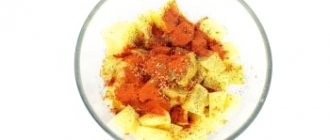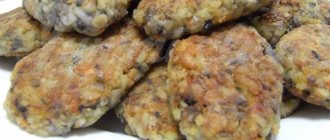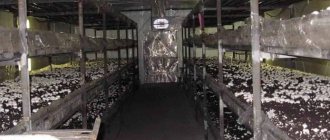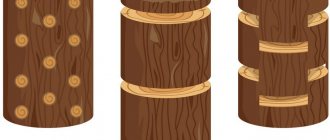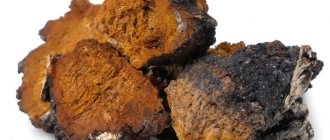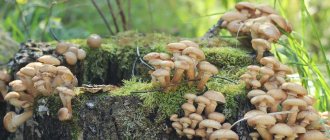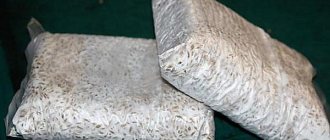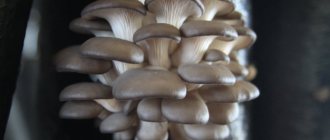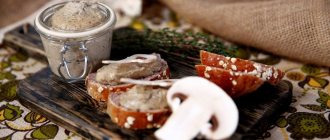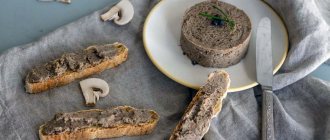Oyster mushrooms are grown quite successfully today by many enthusiastic people in their own garden plots or in utility rooms. It is not difficult to grow these tasty mushrooms, and there is always a demand for them, but usually the question arises about storing mycelium, which is a specially processed structure of grain or compost origin, on which oyster mushrooms subsequently grow. It is insufficient knowledge about storing mycelium that leads novice mushroom growers to failure.
Growing methods
At home, oyster mushrooms can be grown in intensive and extensive ways. With the intensive method, the environment for growing mushrooms is created artificially, and with the extensive method, natural conditions are used. The extensive method is financially more profitable, since it practically does not require investment.
Each of these methods has its drawbacks. Mushrooms grown in the natural environment produce a harvest only once a year. Their harvest directly depends on environmental conditions. Another method involves significant investments and many more subtleties in organizing the process.
Mostly at home, oyster mushrooms are grown in cellars . It is much easier and more convenient to organize it there. Both methods are acceptable for working in the cellar. It depends on your desires and capabilities. In essence, the technology for growing oyster mushrooms is the same for both methods, only the amount of harvest is different.
Let's talk about an intensive method that uses a substrate.
Intensive and extensive growing methods
The intensive method is borrowed from industry and adapted for the home. It will allow you to harvest the first harvest 2 months after planting at any time of the year.
The extensive method is close to natural conditions and will allow you to grow oyster mushrooms even in the garden. It requires less investment, but bears fruit only during the mushroom season, but can produce oyster mushrooms for several years.
Basement requirements
Before you start growing mushrooms, you need to know for sure that your basement meets all the necessary requirements. Failure to comply with even one of them will have a detrimental effect on the microclimate, which will lead to the destruction of the crop.
What conditions should be in the basement?
- Constant temperature from +10 to +20 degrees C.
- Air humidity 85-90%.
- Good ventilation system.
- Absence of various pests, and most importantly, mold.
- Maintaining cleanliness.
How to process oyster mushrooms after harvesting
After collection, they need to be processed as soon as possible, since this product is perishable. The whole process can be divided into the following stages:
- Screening . First of all, the crop needs to be inspected. Old, wormy, rotten, damaged, frostbitten or moldy specimens should be thrown away. The presence of mucus is also a signal that the mushroom is unfit for consumption.
- Sorting . Depending on the type of subsequent preparation, the harvest is sorted by size and quality. To do this, the groups must be divided into separate instances. Small dense fruiting bodies are well suited for any type of preparation. Larger and older ones can be identified for boiling and frying.
- Cleaning . Excess debris and insects must be removed from the surface of the caps and bodies. A hard sponge is often used for this purpose, but you can also use a knife. It is recommended to cut out minor darkening and damage.
- Washing . This procedure is not necessary if the harvested crop is intended to be frozen or dried. In other cases, such cleaning is necessary.
Basement preparation
As always, any preparation of the room should begin with the simplest task - cleaning. With its help, you can identify and eliminate any shortcoming. At the same time, you will prepare space for shelves and other equipment.
To maintain the required temperature, take care of the airtightness of the room and heating. In principle, for the basement it is enough to simply insulate the walls and floor, and then a regular heater will help you out, which will only be enough to turn on once a day.
Humidity
Air humidity depends not only on temperature, but also on how dry it is. If the basement suffers from groundwater from time to time, then maintaining the required humidity will be quite difficult. When all the problems with the tightness of the basement are solved, you will humidify the air in it with irrigation.
Mold
Mold in the basement is a big problem that can cause trouble when growing mushrooms and prevent you from getting a good harvest. You need to fight it by warming up the room, carrying out frequent cleanings and applying antifungal paint to the walls.
Pest control
If you suspect the presence of pests in your basement, immediately disinfest the room. You can do this yourself or contact a specialist. The most effective are smoke bombs and industrial insecticides. Do not forget that at least a week should pass between processing and placing bags of substrate.
Cleaning
The final step in preparing the cellar is cleaning and disinfection. This is done using bleach or a 1% chlorine solution. You will also need, in addition to the basement, to have a separate and warm compartment for incubating oyster mushrooms.
Suitable premises for culture cultivation
When thinking about how to grow oyster mushrooms, everyone who wants to try their hand should be aware that it is necessary to find a suitable room for the plantation.
The space must meet certain requirements.
So, the practice of successful mushroom farms shows that the following are suitable for successful production:
- Food storage;
- Underground bunkers or bomb shelters;
- Basements of residential buildings or technical buildings;
- Wine cellars;
- Greenhouses with good thermal insulation and shaded coverage;
- Unused stables or barns;
- Tunnels;
- Agricultural hangars.
Along the perimeter of the walls there are shelves or places for mushroom blocks - the location depends on the individual preferences of the farmer (you can build walls, hang them, put blocks on top of each other).
The most convenient and compact sections are those that resemble an open closet. Each shelf is equipped with a special pin that secures the substrate. If necessary, the heap simply turns, but does not move from its place - it is convenient not only to grow, but also to harvest.
The room temperature should not rise above 25 degrees Celsius, and this does not take into account artificial influences. It is very important to maintain a certain microclimate, since the mushroom mycelium can quickly die, and already sprouted fruits can deteriorate. Cold is also harmful to oyster mushrooms, so unheated rooms can be used for growing the crop exclusively in the warm season or where a warm climate prevails.
It is imperative to provide electric lighting to the plantation - oyster mushrooms need at least dim light, but still light.
Not to mention the agronomists who control the process of fruit growth.
If things are done successfully and correctly, one oyster mushroom ripening cycle takes 7-8 weeks. The shelf life of one batch of substrate with mycelium is up to three harvests. Experienced growers recommend stopping at the second wave of fruiting, since all subsequent ones decline and may not be worth the effort.
Substrate purchase
When the room for growing mushrooms is prepared, the mycelium and substrate where oyster mushrooms grow are purchased. The substrate is hay, dried stems, husks of seeds or buckwheat, and shavings of deciduous wood.
Remember! The substrate must be completely free of rot and mold!
Preparing the substrate yourself is quite troublesome and difficult, so it is better to use something purchased. When purchasing a substrate, study its composition and make sure that it is as suitable as possible for growing oyster mushrooms.
How to make bags with substrate for growing oyster mushrooms
You will need plastic bags of such a volume that they can hold at least 6 kg of material for planting. It is important to disinfect these bags by first rinsing them and placing them in a chlorine solution. Then you can fill it out. The bottom layer is 6 cm of substrate, then half a centimeter of mycelium.
And so alternate until the very top. Afterwards, the bag is tightly tied and small holes are made in it through which the mushrooms will begin to sprout. The distance between the holes is at least 15 cm, and the size of the slots is a couple of centimeters.
Substrate processing
The substrate is processed in several ways:
- hot water;
- blow steam onto the wet substrate;
- blow steam over the dry substrate.
The substrate is treated to increase its looseness and enrich it with oxygen. The roots of the mushrooms will live in comfortable conditions, so this will help speed up their cultivation and have several decent harvests per year.
To avoid mold, the substrate must be dried very well after washing. Dry it in a warm place for 2 days until all excess liquid is gone. Then it needs to be crushed and mixed. This will help the substrate retain water better. Now the material is completely prepared for planting oyster mushrooms.
If you want to purchase “mycelium”, then carefully consider the supplier. Don’t take a lot at once, but take a small batch for testing. Study the information about the mycelium in the certificate. Especially such items as resistance to diseases and fungi, germination rate, shelf life.
The mycelium is healthy if it does not smell of ammonia and does not show signs of mold (black, gray spots). When healthy, it is yellowish in color.
Drying mushrooms
You can dry mushrooms in the oven or outdoors. Before drying, use a knife to scrape off any adhering dirt from the oyster mushrooms (without using water!). Then wipe each mushroom with a cloth, cut off the stems from the caps and place the caps on a sheet of paper. Oyster mushrooms are dried in the shade, in a ventilated place.
You can place them on a wire or strong thread. To understand whether the oyster mushrooms have dried, you need to break off a small piece from the mushroom - if it breaks and does not bend, it means it is dry. On average, they dry for about a day.
You can also dry them in the oven. To do this, oyster mushrooms are peeled, cut and placed on a dry baking sheet.
Dried mushrooms are stored in containers with tight-fitting lids. Shelf life – 1 year. Before cooking, dry oyster mushrooms should be immersed in hot water for an hour or two, and then you can start cooking.
Storing mycelium
Compliance with the conditions for storing mycelium is of great importance. Oyster mushroom mycelium is stored at a temperature of +3 - +4 degrees C. During transportation, the temperature is maintained at no more than +20 degrees. If all these conditions are met, then their shelf life may not be lost for six months to 9 months. Mycelium purchased in bags should be left for one day at normal temperature. Then the bags are laid out tightly so that air can flow freely. The sooner planting begins, the better, since at home the shelf life of the mycelium is significantly shortened.
Storage methods and features
Today there are two known ways to store mycelium. Both of them are usually used in large industries. This is storing the mycelium in the cold and placing it in liquid nitrogen.
The first method involves placing oyster mushroom mycelium in the refrigerator. The disadvantage of this method is the difficulty in recognizing the active structure. Therefore, before use, the mycelium is removed from the refrigerator, shaken vigorously and left at room temperature for several days. Active mycelium will begin to grow rapidly, while spoiled grain will remain bare and its color will be unpleasantly brown.
A more advanced way to preserve oyster mushroom mycelium is to place it in liquid nitrogen. In addition to the fact that this substance allows you to well preserve the structure in which oyster mushrooms will grow in the future, it has a beneficial effect on the quality of the final product and on the productivity of the mycelium.
Before storing the mycelium, it is kept for several days at a temperature of about 5 degrees Celsius. The freezing process itself is carried out very slowly and under careful control. Before planting, the mycelium is slowly defrosted.
As laboratory experiments show, it is best to store mycelium in liquid nitrogen, since with this method practically no changes occur and all its properties remain almost the same as before storage.
Cooling mycelium with liquid nitrogen using a refrigerator
Bookmark mycelium
Before planting, the mycelium is crushed with great care. They do this without opening the package. Then the bags are transferred to the basement for a short time so that the temperature returns to normal and the mycelium does not die from the shock.
Open the package with mycelium in a clean, well-treated place. To do this, you need to use gloves and disinfect the work surface with an alcohol solution. It is very important not to forget that growing oyster mushrooms and planting mycelium should take place in different places. This is done so as not to infect the mycelium.
If you have limited space, then at least build a bulkhead to isolate a small space in the cellar.
When and where to collect
Collection time is from September to December. In European countries and Russia they grow actively throughout the fall. Oyster mushrooms love low temperatures and appear after cold snaps. They can also grow in summer if the temperature is low for a long time. In different regions, the collection time may also fall in the spring.
Many mushroom pickers make a mistake when they go in search of this mushroom - they, as in a normal search, habitually look at their feet, while they need to look up and to the sides. Oyster mushrooms are located on tree trunks, which is where they get their name - they grow in a suspended state. Most often, they choose a birch tree as a place to grow. This is their favorite tree.
But you can find them on aspens, willows, and even pine trees. Coniferous trees rarely fall prey to this predator, but when searching, it is recommended to inspect all trees. If you decide to go collecting oyster mushrooms, then it is best to go to a deciduous forest in the fall. But there is a chance to meet them almost everywhere and at almost any time of the year.
Important! When harvesting, cut off the entire group, even the smallest fruiting bodies. They will not survive if their larger neighbors are cut off.
Growing
Oyster mushrooms are grown in several stages. First, the substrate is processed. This has already been discussed above. The easiest way to do this is with hot water. You need enough of it to cover the substrate. You need to boil for 90 minutes. If you want to boil the substrate directly in the package, then you need to make holes in it for good water circulation. When you drain the water, place the substrate under pressure for 24 hours to drain off excess moisture.
The mycelium is planted in good sanitary conditions. Before this, you should disinfect the basement, treat the bags with an alcohol solution and wear gloves. The ventilation in the cellar should be turned off for a while so that the fungus does not spread anywhere. The workplace must be washed with a disinfectant solution and then with water.
Bookmark mycelium
Now the preparation is complete and you can proceed directly to the bookmarking process. The mycelium and substrate are poured onto a clean table and mixed on it.
The resulting mixture is compacted tightly and distributed into bags (from 10 to 15 kg). If you are growing oyster mushrooms for the first time, then use small bags up to 5 kg in volume. This will make it easier for you to monitor the temperature in the bag.
The packaged mixture is pressed well on one side so that the bag is flattened, and holes are made on the other side. The holes are cut with a very sharp and clean knife. The angle of the cut should be 45 degrees and the length of the cut should be 5 cm.
The crushed bags are placed in the incubation room, where the temperature is maintained at +25 degrees C. The bags with the substrate are placed on shelves spaced 5 cm or more apart so that air is easily accessible to the holey sides. You cannot stack bags on top of each other. When all this work is completed, you can move on to the next stage - incubation.
Incubation
In the incubation room, the temperature must be maintained at a constant level and not deviate by more than 1-2 degrees C. If the room temperature is more than 30 degrees C, the mycelium will overheat and there will be no mushrooms. Even small temperature fluctuations reduce the quantity and quality of seedlings.
During the incubation period, the room is not ventilated. Carbon dioxide is released from the bags, creating comfortable conditions and slightly increasing humidity. To prevent the development of mold and disease at this stage, you need to clean the room every day, using chlorine-containing products .
Typically the incubation process takes about 3-4 weeks. After this period, oyster mushrooms enter the last stage, which is called cultivation.
Storing oyster mushrooms in the freezer
Can oyster mushrooms be frozen? It is possible, but you need to do it wisely. The first thing you need to do is buy the “right” mushrooms. Any kind will not be suitable for freezing - choose firm ones without stains. The main criterion is the smell, so be sure to smell them when buying.
Carefully examine the mushrooms; do not purchase them if there are cracks along the edges of the caps. They are a sign that the oyster mushrooms are not very fresh and are not suitable for freezing. Fresh mushrooms have an elastic cap, without cracks or spots.
The leg of the oyster mushroom is not so tasty, it has little nutritional value, so the shorter the leg, the better.
Frozen mushrooms can be stored in the freezer for up to a year, without losing any nutritional or beneficial properties. Before packing them in the freezer, they must be cleaned of debris and dirt, but water cannot be used, as it will freeze and turn into ice. After cleaning, they are divided into portions and packed into bags or containers - this is done in order to not defrost all the mushrooms, but to take them in portions, since re-freezing is unacceptable.
If you have broken and not very fresh oyster mushrooms, then it is better to boil them before freezing.
Chop them and boil for 5 minutes. The cooled oyster mushrooms should be placed on a napkin, allowed to dry a little, and then packed and put in the freezer. It is also practiced to store fried mushrooms by frying them until all the moisture has evaporated. Place the cooled oyster mushrooms in a container and freeze.
There is another way to prepare oyster mushrooms for freezing. To keep them longer, they need to be dried in the oven. Chop the oyster mushrooms, place them on a baking sheet without using oil and dry. When all the moisture has come out of the mushrooms, you can take them out, cool and freeze them.
Completion of cultivation
At this stage, the bags are carefully transferred to the cellar and placed in a vertical position close to each other. The final growing process is tied to the conditions that you can create in your basement. The humidity in it should range from 85 to 95%. If you need to grow light mushrooms, keep the temperature at +10 degrees C, and higher temperatures (up to +20 degrees C) give a dark color to the cap. But the taste of mushrooms does not suffer from color. At this time, there should be 5W of lighting for each m2 of area.
Oyster mushrooms: description and photo
Oyster mushroom or, as it is popularly called, oyster mushroom, is an edible mushroom of the oyster family. It is widespread in temperate forests. It grows in groups on stumps, dead wood and trunks of deciduous trees. Their number in a group can be 30 or more fruiting bodies, which grow together at the base, representing a kind of “bouquet”.
The fungus itself is a pest for trees, as it causes yellow rot in them. The more rot that forms, the more oyster mushrooms can be found in that area. If a tree dies due to infection, they can continue to grow on it, which is why this fungus is considered to be predatory.
Oyster mushroom is edible and does not pose a threat to the human body; it also has no resemblance to poisonous species.
The specimens grow large, the diameter of the cap can reach 10 cm. It feels dense, fleshy, has a thin edge, and the general shape is round. Age can be determined by the shape of the cap - if it is convex, then the mushroom is young, and if it is flat, then it is old. The color can vary from yellowish to ashy with a purple tint.
The leg is usually short. Often you may not even notice it under a large hat. The pulp is juicy, white and dense. Over time, it becomes tougher and more fibrous. It has practically no smell. The taste, according to many reviews, is soft and pleasant. May resemble anise. This is due to the benzaldehyde content in the chemical composition.
Did you know? In terms of protein content, oyster mushrooms can be compared to dairy products or meat. This figure is 2.5 g per 100 g.
How much and how to store in the freezer
The freezer allows you to preserve your harvest for a long time without losing its taste and beneficial qualities.
Important! If defrosting occurs due to a power outage or other circumstances, mushrooms cannot be re-frozen. This will significantly degrade their quality.
To understand how long you can freeze for, you need to check the deep-freezing temperature conditions:
- -12…-14°С – 3–4 months;
- -14…-18°С – 4–6 months;
- -18…-24°С - up to 1 year.
Do not forget about preliminary preparation and proper packaging of fruiting bodies. No more than 1 kg should be stored in one container.
Now you know how to properly store purchased or collected oyster mushrooms. Follow the advice in this article, and these mushrooms will be able to delight you with their taste and benefits for a long time.
How long does it last in the refrigerator?
You can find the approximate temperature conditions and shelf life below:
- +7…+10°С – 12–17 hours;
- 0…+5°С – 24–72 hours;
- -2…0°C – 72–96 hours.
Manufacturing plants often use refrigerators that can maintain a constant temperature down to -2°C, which can extend their shelf life by up to 2 weeks. For longer storage, it is recommended to use deep freezing.
